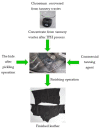Application of an Integrated System of Thermal Pressure Hydrolysis/Membrane Techniques to Recover Chromium from Tannery Waste for Reuse in Hide Tanning Processes
- PMID: 36676827
- PMCID: PMC9861388
- DOI: 10.3390/membranes13010018
Application of an Integrated System of Thermal Pressure Hydrolysis/Membrane Techniques to Recover Chromium from Tannery Waste for Reuse in Hide Tanning Processes
Abstract
This paper presents the results of research on a new method of chromium recovery from solid waste generated during the tanning of raw hides. In the first stage, the shredded mixture of useless leather scraps is decomposed through thermal pressure hydrolysis (TPH) in nitric acid in appropriate process conditions. Then, the liquid product of this process (hydrolysate) is fractionated using membrane separation techniques. The microfiltration (MF) process enables the initial purification of the hydrolysate by concentrating the organic matter. On the other hand, the nanofiltration (NF) process enables a three-fold concentration of total chromium in the pre-purified hydrolysate. The total chromium concentrate prepared in the above manner was successfully used in the model tanning processes. These processes were carried out on pickled bovine hides, using a mixture of a commercial chromium tanning agent and chromium concentrate after nanofiltration. The reference sample was bovine hide traditionally tanned with a commercial chromium tanning agent. Based on the results of the physical and chemical analyses, it was found that the properties of hides tanned using chromium recovered from waste are similar to those of hides tanned traditionally using a commercially available chromium tanning agent. The industrial implementation of the developed tannery waste valorisation technology would enable transition from a linear economy to circular economy.
Keywords: chromium(III); circular economy; microfiltration (MF); nanofiltration (NF); tannery waste; thermal pressure hydrolysis (TPH).
Conflict of interest statement
The manuscript’s authors declare no conflict of interest.
Figures










References
-
- Zhao J., Wu Q., Tang Y., Zhou J., Guo H. Tannery wastewater treatment: Conventional and promising processes, an updated 20-year review. J. Leather Sci. Eng. 2022;4:10. doi: 10.1186/s42825-022-00082-7. - DOI
-
- Chojnacka K., Skrzypczak D., Mikula K., Witek-Krowiak A., Izydorczyk G., Kuligowski K., Bandrów P., Kułażyński M. Progress in sustainable technologies of leather wastes valorization as solutions for the circular economy. J. Clean. Prod. 2021;313:127902. doi: 10.1016/j.jclepro.2021.127902. - DOI
-
- Saha B., Azam F.A.B. Probable ways of tannery’s solid and liquid waste management in Bangladesh—An overview. Text. Leather rev. 2021;4:76–95. doi: 10.31881/TLR.2020.25. - DOI
LinkOut - more resources
Full Text Sources

